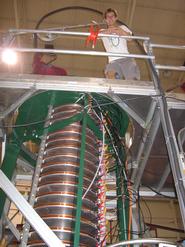
The electroweak force describes the confluence of two fundamental forces in nature (out of four): the electromagnetic force, and the weak force. “Electroweak” is a funny sounding name to begin with, and “weak force” does not sound very scientific – but both are, in fact, complicated concepts in particle physics. The weak force alone governs beta decay and its associated radioactivity. But when combined with the electromagnetic force, it controls neutron beta decay. The aCORN project is an effort to more accurately measure the electron antineutrino correlation termed “little a,” one of the parameters for neutron beta decay. This summer, William Bauder ’10 worked on the aCORN project at Indiana University, which collaborates with the National Institute of Standards and Technology (NIST). Professor of Physics Gordon Jones guided him through the research.
Neutron beta decay is a type of radioactive decay in which a beta particle (electron) and an antineutrino are emitted from an atomic nucleus, and a neutron is converted into a proton. Currently, the value has a large uncertainty (approximately 5 percent systematic error). The aCORN project is hoping to calculate little “a” to within 1 percent systematic error. Their findings will either confirm what is called the “standard model,” or call for revision of the electroweak model.
“The standard model represents…hundreds of years of physics and ultimately represents mankind’s best guess as to how the universe works on a fundamental scale,” said Bauder. NIST is important because it repeatedly confirms or clarifies an assortment of physical constants that most people take for granted.
The grand majority of the aCORN experiment consists of measuring the time between when they can detect the emitted electron and the newly-born proton. The time interval will help determine the value for “little a.” Bauder aligned a system of proton and electron collimators within the apparatus they used, which looks like a metal column with a green, cylindrical frame. A collimator is a device that narrows a beam of particles. These have to align with the magnetic field to within three thousandths of an inch. Now that this task is complete, he and the other scientists must verify that the proton detector will function when the apparatus is placed in a vacuum and cooled with liquid nitrogen, a necessary step in the experiment.
When something goes as planned in a physics experiment, it is a cause for celebration. So when he helped make the magnetic field uniform last summer, Bauder was quite pleased. “It’s a rare and cherished occurrence especially when you spend weeks or months tweaking and correcting,” he said.
After Hamilton, Bauder plans to get his masters degree and doctorate in physics. “I’m interested in physics because I enjoy the puzzle behind it,” he said. “I enjoy the search for a more complete picture of the physical world and its makeup.”
Bauder is a graduate of Central Bucks High School South.
Neutron beta decay is a type of radioactive decay in which a beta particle (electron) and an antineutrino are emitted from an atomic nucleus, and a neutron is converted into a proton. Currently, the value has a large uncertainty (approximately 5 percent systematic error). The aCORN project is hoping to calculate little “a” to within 1 percent systematic error. Their findings will either confirm what is called the “standard model,” or call for revision of the electroweak model.
“The standard model represents…hundreds of years of physics and ultimately represents mankind’s best guess as to how the universe works on a fundamental scale,” said Bauder. NIST is important because it repeatedly confirms or clarifies an assortment of physical constants that most people take for granted.
The grand majority of the aCORN experiment consists of measuring the time between when they can detect the emitted electron and the newly-born proton. The time interval will help determine the value for “little a.” Bauder aligned a system of proton and electron collimators within the apparatus they used, which looks like a metal column with a green, cylindrical frame. A collimator is a device that narrows a beam of particles. These have to align with the magnetic field to within three thousandths of an inch. Now that this task is complete, he and the other scientists must verify that the proton detector will function when the apparatus is placed in a vacuum and cooled with liquid nitrogen, a necessary step in the experiment.
When something goes as planned in a physics experiment, it is a cause for celebration. So when he helped make the magnetic field uniform last summer, Bauder was quite pleased. “It’s a rare and cherished occurrence especially when you spend weeks or months tweaking and correcting,” he said.
After Hamilton, Bauder plans to get his masters degree and doctorate in physics. “I’m interested in physics because I enjoy the puzzle behind it,” he said. “I enjoy the search for a more complete picture of the physical world and its makeup.”
Bauder is a graduate of Central Bucks High School South.
